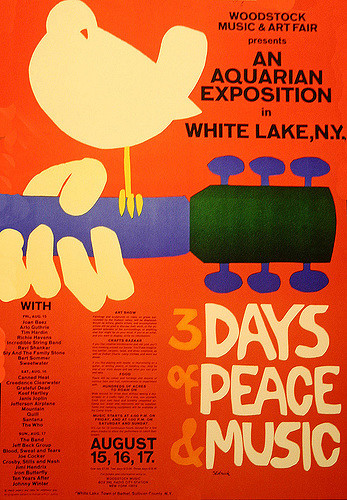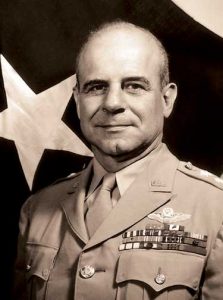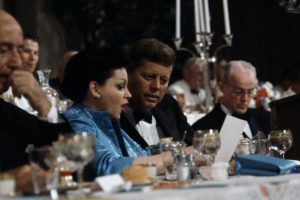The Sixties. We think of the Vietnam War, Civil Rights protests, the assassination of John F. Kennedy, the Apollo landing on the moon, hippies, Peace on Earth, and most importantly, the music. Music is how famous musicians express their thoughts and feelings to a broader audience.1 The Sixties made history through its music and more iconically, through a three-day concert known as Woodstock.

It all started with four young men that wanted to build a recording studio: John Roberts, 26-years-old, and an heir to a drugstore and a multi-million dollar trust fund; Joel Rosenman, 24-years-old, a Yale Law School graduate, and guitar player for a lounge band in Long Island and Las Vegas hotels; Artie Kornfeld, 25-years-old, a songwriter, producer, and the vice president of Capitol Records; and finally, Michael Lang, 23-years-old, and owner of a head shop that sold accessories for weed, tobacco, and other recreational drugs in Florida.2 All four men met in February of 1969 and came up with the idea of creating a rock festival, and they discussed the budget for it. They met several times after to discuss other ideas for the festival. And by their last meeting, they had a budget of five hundred thousand dollars, and were hoping for fifty thousand people to attend. Unknowingly, their “Woodstock” would become the world’s largest and most remembered Rock concert of all time.

In March of 1969, the four young men formed the Woodstock Ventures company, and each man held a twenty-five percent stake in it.3 The team now needed a location for the concert; they decided to hold the concert in a three hundred acre dairy farm in Bethel, New York, because it offered easy access from New York City, less than a mile from Route 17. And it offered electricity and water lines.4 They paid seventy five thousand dollars for the rental of the property to Max Yasgur, the owner.5 By April, Kornfeld and Lang wanted to advertise and introduce Woodstock as a place of freedom with music. They had promoters create a Woodstock image for the public. The group came up with the slogan “Three Days of Peace and Music,” because they figured, if people read “peace” in the poster, it would keep the public calm and the event free of violence. The group then hired artist Arnold Skolnick to create the image for a poster. What people thought was originally a dove on the Woodstock poster was actually a catbird, which was one of Arnold’s favorite things to draw. When Arnold finally completed the drawing for the Woodstock poster, it featured a catbird sitting on a flute along with the slogan, “Three Days of Peace and Music.” This design was approved by Woodstock Ventures. However, at the last minute, Arnold made a minor change by having the catbird stand on a guitar instead of the flute, and the poster was completed.6
Woodstock Ventures wanted the most popular rock’n’roll bands to perform at the concert. They composed contracts for each band member attending, which came with promising paychecks. They signed Jefferson Airplane for twelve thousand dollars, Creedence Clearwater Revival for eleven thousand five hundred dollars, and The Who for twelve thousand five hundred dollars.3 They had a total of thirty-two bands listed to play, including Janis Joplin, The Grateful Dead, Joe Cocker, Crosby, Stills, Nash and Young, and others. The highest paid performer was Jimi Hendrix, who signed for thirty-two thousand dollars. Hendrix would be the last act to perform and he famously closed the festival with his version of the “Star Spangled Banner,” which has gone down in history as one of the greatest performances of his career.8 Woodstock Ventures paid a total of one hundred and eighty thousand dollars for all the musicians who performed in the concert. Lang made the decision that he did not care what it would cost to get a rock band to perform for Woodstock. They would pay the deposit and create the contracts at whatever cost to ensure that they had the best performers.
By the spring time, advertisements for Woodstock started appearing in the New York Times and on radio stations across the country.9 While Woodstock Ventures had originally expected fifty thousand people to attend the festival, they sold a total of one hundred and eighty six thousand tickets, costing six dollars per day.10 In August, one week before show time, Kornfeld wanted to capture the stories of the people, their thoughts about Vietnam War, and their thoughts about Woodstock. Kornfeld made an offer with Warner Brothers to document the festival. Woodstock Ventures paid one hundred thousand dollars to have the festival filmed, and a contract was signed agreeing that if the film made it big they would get paid double the amount, and if it failed they would get nothing.
On August 14, 1969, the day before the festival, early in the morning, Woodstock Ventures noticed that traffic was backed up ten miles long on Route 17, and they were shocked to see that so many people were attending. An estimated twenty five thousand people were already waiting before the festival began.11 The four young men knew this concert was going to be amazing, but they never thought that it would go down in history as one of the biggest and “the greatest peaceful events in history,” as Time magazine called it.12

Throughout the years many attempts to recreate another Woodstock have failed. The Woodstock of 1969 will forever go down in history for its great music, the psychedelic people, and most importantly, a once in a lifetime event that can never be forgotten.
- Alan Brinkley, American History: Connecting with the Past Volume 2 (New York: McGraw-Hill Education, 2014), 812-813. ↵
- “How Woodstock Happened,” reprinted from The Times Herald-Record, 1994. http://www.edjusticeonline.com/woodstock/history/index.htm. (accessed November 17, 2016). ↵
- “How Woodstock Happened,” reprinted from The Times Herald-Record, 1994. http://www.edjusticeonline.com/woodstock/history/index.htm. (accessed November 17, 2016). ↵
- “Woodstock Music Festival.” History.com, 2009, http://www.history.com/this-day-in-history/woodstock-music-festival-concludes. (accessed November 10, 2016). ↵
- “How Woodstock Happened,” The Times Herald-Record Woodstock Commemorative Edition, 1994, http://www.edjusticeonline.com/woodstock/history/index.htm. (accessed November 17, 2016). ↵
- “How Woodstock Happened,” The Times Herald-Record Woodstock Commemorative Edition, 1994, http://www.edjusticeonline.com/woodstock/history/index.htm. (accessed November 17, 2016). ↵
- “How Woodstock Happened,” reprinted from The Times Herald-Record, 1994. http://www.edjusticeonline.com/woodstock/history/index.htm. (accessed November 17, 2016). ↵
- Spencer Bright, “Forty far-out Facts you never knew about Woodstock,” Daily Mail, August 7 2009. ↵
- “How Woodstock Happened,” The Times Herald-Record Woodstock Commemorative Edition, 1994, http://www.edjusticeonline.com/woodstock/history/index.htm. (accessed November 17, 2016). ↵
- Daily Mail, August 2009, s.v. “Forty far-out Facts you never knew about Woodstock,” by Spencer Bright. ↵
- “How Woodstock Happened,” reprinted from The Times Herald-Record, 1994. http://www.edjusticeonline.com/woodstock/history/index.htm. (accessed November 17, 2016). ↵
- Daily Mail, August 2009, s.v. “Forty far-out Facts you never knew about Woodstock,” by Spencer Bright. ↵




75 comments
Christian Lozano
It is awesome seeing how four people could come together filled with dreams, to create one of the biggest Music Festivals to ever grace the face of the planet. It makes me wonder what I and a few other people could achieve if we set our minds to it. Great Job! Keep it up!
Nicolas McKay
This article was far out.Like many others, I knew what Woodstock was, hearing it referenced multiple times in history and pop culture, but I knew nothing about it. The very notion that one of the greatest events in all time was started by four guys with a passion for music is simply incredible. Reading the actual history behind it is truly incredible.
Erik Rodriguez
Wow! That is just crazy! I had no idea that Woodstock was created by four men! I could not imagine starting up an event of this caliber! It certainly left a moment never to be forgotten and something the music world will never take for granted.
Awesome article! Keep up the good work!
George Manzanares
Nicely done! Music indeed was a crucial component of the 60’s in American society! I had no idea that Woodstock was a collective effort of four men! I never realized that they did not know that their event would go down in history as one of the most important moments in the history of music! Well done on illustrating the event in your article!
Mariana Sandoval
Many people know what Woodstock is, but I think it’s safe to say that most people don’t know the history behind the festival and how it came into being. Your article was very information in that area in that it told the back story about the four men that came up with the idea to start the festival and what all went into that decision afterwards. Well done!
Aaron Jaramillo
Loved hearing about this iconic music festival. It is amazing the amount of money that those four guys had for a budget. Also, the amount of money that they paid to the bands and artist to perform. Interesting how creative advertisement, the use of the word peace, helped keep the event calm and free of violent. Lastly, what a deal to see all those iconic bands for a six dollar a day entrance fee. WOW.
Kimberly Rios
Great article! I have always been interested in music festivals and reading about Woodstock is extremely interesting! Woodstock was truly iconic and it can be seen as the start of all music fesitivals. I never put much thought into how much money it takes to put up a festival and grand as this one but after reading the information you provided I am shocked at how much it really is. One can only wish to have attended such a great event and I am envious of whoever did. Keep up the good work!
Ivanna Rodriguez
I absolutely LOVED your article! I was extremely intrigued to learn about the creation of Woodstock. How the best music festival in history was created by four men. That these four men were willing to pay whatever it took to have the best bands perform. Thus, creating one of the best music lineups in history. I also loved learning that for three days it was just “peace and music.” Your article was on an incredible subject. Awesome job! Keep it up!
Vanessa
great article on how Woodstock all started with 4 guys!! Makes me want to go back in time!
Celina Resendez
Oh my gosh Aurora, I loved this article! I have no idea that it only took for men to come up with the idea and make it happen. It’s even crazier that they had no idea how huge this event would become. I was sad when it was over because I wanted to read more about peoples experiences and the music! Again, great job!